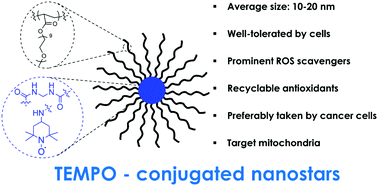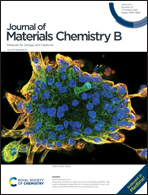Nitroxide-functional PEGylated nanostars arrest cellular oxidative stress and exhibit preferential accumulation in co-cultured breast cancer cells†
Abstract
The limited application of traditional antioxidants to reducing elevated levels of reactive oxygen species (ROS) is potentially due to their lack of stability and biocompatibility when tested in a biological milieu. For instance, the poor biological antioxidant performance of small molecular nitroxides arises from their limited diffusion across cell membranes and their significant side effects when applied at high doses. Herein, we describe the use of nanostructured carriers to improve the antioxidant activity of a typical nitroxide derivative, (2,2,6,6-tetramethylpiperidin-1-yl)oxyl (TEMPO). Polymers with star-shaped structures were synthesised and were further conjugated to TEMPO moieties via amide linkages. The TEMPO-loaded stars have small hydrodynamic sizes (<20 nm), and are better tolerated by cells than free TEMPO in a breast cancer-fibroblast co-culture, a system exhibiting elevated ROS levels. At a well-tolerated concentration, the polymer with the highest TEMPO-loading capacity successfully downregulated ROS production in co-cultured cells (a significant decrease of up to 50% vs. basal ROS levels), which was accompanied by a specific reduction in superoxide anion generation in the mitochondria. In contrast, the equivalent concentration of free TEMPO did not achieve the same outcome. Further investigation showed that the TEMPO-conjugated star polymers can be recycled inside the cells, thus providing longer term scavenging activity. Cell association studies demonstrated that the polymers can be taken up by both cell types in the co-culture, and are found to co-locate with the mitochondria. Interestingly the stars exhibited preferential mitochodria targeting in the co-cultured cancer cells compared to accompanying fibroblasts. The data suggest the potential of TEMPO-conjugated star polymers to arrest oxidative stress for various applications in cancer therapy.



 Please wait while we load your content...
Please wait while we load your content...